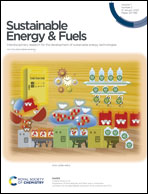Extractive-catalytic oxidative desulfurization of a model fuel over vanadium-containing heteropolyacids immobilized on amine-functionalized magnetic graphene oxide: a comparative study between Keggin and Dawson-type heteropolyacids and process optimization via response surface methodology
Abstract
Keggin and Dawson-type vanadium-containing heteropolyacids (HPAs) were synthesized and then covalently immobilized on amine-functionalized magnetic graphene oxide (APTES–MGO). Several techniques, including XRD, SEM-EDX, FT-IR, VSM, TGA, ICP-OES, N2 adsorption–desorption isotherms, and Raman spectroscopy, were used to characterize the samples. Catalytic activities of the supported HPAs (HPAs@APTES–MGO) and also their parent HPAs in the bulk form were investigated on dibenzothiophene (DBT) removal in an extractive-catalytic oxidative desulfurization (ECODS) process. To assess the desulfurization performance of each catalyst prepared in this work, a series of ECODS processes were performed under certain conditions. The results show that the catalysts displayed acceptable efficiencies in DBT conversion. However, supported HPA catalysts represented much higher conversion than their bulk form. In addition, the results revealed that K-PV2@APTES–MGO (K-PV2, is the abbreviation of H5PMo10V2O40) had the highest sulfur removal efficiency. Meanwhile, the effect of the K-PV2 load percentage (20, 30, 40, and 50 wt%) was examined, and the catalyst with 40 wt% K-PV2 loading gave the highest DBT removal. Then, the influence of important process variables on the ECODS process, including reaction temperature and time, H2O2/DBT molar ratio, and catalyst dosage, were studied via the Box–Behnken Design (BBD). A complete DBT removal from the model fuel can be achieved within 30 min at 45 °C using 4.5 g 40-K-PV2@APTES–MGO catalyst per L of fuel, and a molar ratio of H2O2/DBT = 7. After each ECODS run, catalyst separation and recovery were performed by simply utilizing an external magnetic field without noticeable mass loss. The 40-K-PV2@APTES–MGO catalyst exhibited more than 95.0% DBT removal efficiency even after 9 times of regeneration, exhibiting the outstanding stability of the catalysts. Furthermore, the reaction mechanism of the catalyst for the ECODS process was studied.



 Please wait while we load your content...
Please wait while we load your content...